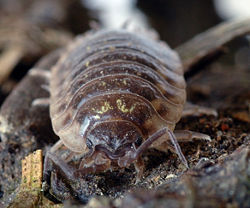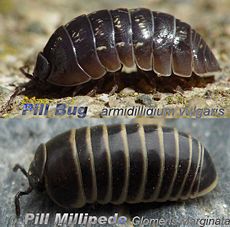Woodlouse
| Woodlice | ||||||||||||
|---|---|---|---|---|---|---|---|---|---|---|---|---|
 Oniscus asellus
|
||||||||||||
| Scientific classification | ||||||||||||
|
||||||||||||
| Infraorders and Families | ||||||||||||
|
Woodlice (known by many common names; see below) are crustaceans with a rigid, segmented, long exoskeleton and fourteen jointed limbs. They form the suborder Oniscidea within the order Isopoda, with over 3,000 known species.
Woodlice in the genus Armadillidium can roll up into an almost perfect sphere as a defensive mechanism, hence some of the common names such as pill bug or rolly-polly. Most woodlice, however, are not able to do this.
Contents |
Ecology
Woodlice need moisture because they breathe through gills, called pseudo trachea, and so are usually found in damp, dark places, such as under rocks and logs. They are usually nocturnal and are detritivores, feeding mostly on dead plant matter. Woodlice then recycle the nutrients back into the soil. In artificial environments such as greenhouses where it can be very moist, woodlice may become abundant and damage young plants, such as ferns.
The woodlouse has a shell-like exoskeleton, which it must progressively shed as it grows. The moult takes place in two stages; the back half is lost first, followed two or three days later by the front. This method of moulting is different from that of most arthropods, who shed their cuticle in a single process.
A female woodlouse will keep fertilized eggs in a patch on the underside of her body until they hatch into small, pink offspring. The mother then appears to "give birth" to her offspring.
Some species of woodlice are able to roll into a ball-like form when threatened by predators, leaving only their armoured back exposed. This ability, or dominant behavior, explains many of the woodlouse's common names.
Metabolic rate is temperature dependent in woodlice. In contrast to mammals and birds, invertebrates are not "self heating": the external environmental temperature relates directly to their rate of respiration.
They are not generally regarded as a serious household pest as they do not spread disease and do not damage wood or structures; however, their presence can indicate dampness problems.
Wood and Timber Damage
The woodlouse buries itself into damp rotten wood and eats away at it often resulting in extensive damage to the interior of wood. It is too late then to fix the problem, see preventative action needed for wood preservation.
Aquatic isopods
Although woodlice are terrestrial crustaceans, several forms have returned to water. Although most of these are amphibious, some have become truly aquatic, such as the sea slater (Ligia oceanica), which belongs to family Ligiidae.
Other examples include some Haloniscus species from Australia (family Scyphacidae), and in the northern hemisphere several species of Trichoniscidae and Thailandoniscus annae (family Styloniscidae), as well as Idotea wosnesenskii, common in the pacific northwest. Species for which aquatic life is assumed include Typhlotricholigoides aquaticus (Mexico) and Cantabroniscus primitivus (Spain) [1].
Common names
Common names for woodlice vary throughout the English-speaking world. A number of common names make reference to the fact that some species of woodlice can roll up into a ball. Other names compare the woodlouse to a pig.
Names include: "armadillo bug" [2], "cheeselog" (Reading, Berkshire) [3], "cheesey-bug", "doodlebug" (also used for the larva of an antlion) [4], "pill bug" (usually applied only to the genus Armadillidium) [2], "roly-poly" [5],"parson's pig" (Isle of Man) "potato bug"[5], "roll up bug" [6], "slater" [7], "Hodidod" (Suffolk) "Carpenter", "Wood Bug","sow bug", "pea bug", And "ball bug."
In north Devon and north Somerset, England, a woodlouse is traditionally referred by the quaint name "Chuggy-peg", "Chuggy-pig" or "Chuggypig". [8] In North Somerset it is also sometimes referred to as a "Granfer Gravy". In Cornwall it is known as a grammersow, or little-village.
In Australia, a woodlouse is referred to as a "butchie boy", or "butcher boy", or "slater", or "slater bug". In New Zealand the word "slater" is used as well.
United Kingdom
There are 37 native or naturalised species in the United Kingdom, ranging in colour and in size (3–30 mm) of which only five are common: Oniscus asellus (the common shiny woodlouse), Porcellio scaber (the common rough woodlouse), Philoscia muscorum (the common striped woodlouse), Trichoniscus pusillus (the common pygmy woodlouse) and Armadillidium vulgare (the common pill bug). They are also called "wood bugs" and "slaters" in some areas. Many preschoolers like to call them "Rollie Pollies".
Populations of Oniscus asellus and Porcellio scaber are now declining in North-West England, not least due to the over-use of these species in school biology experiments.
The region of Kent has several common names for woodlouse; North Kent (Dartford and Gravesend) name them "Cheesy Bugs" and "Cheesy Logs", Folkestone, Whitstable, Dover and Canterbury typically call them Monkeypeas, which is similar to the commonly accepted Peabug -referring to the fact that many of the species roll into balls.
In The Purbeck region of Dorset (Particularly in the Quarrying communities) They are Known as "Hobby Horses"
Other names; carpenters, cheesybobs, cheesypigs, cheesypegs, roly polys, granny greys, billy buttons, slater bugs, slater beetles, coffin cutters, tiggy hogs, grey sows, sow bugs, potato bugs, doodle bugs, chuggy pegs, chuggy pigs, chuggy bugs and finally leather jackets.
Pillbugs and pill millipedes

Pillbugs (woodlice of the family Armadillidiidae) can be confused with Pill millipedes although they are only very distantly related to one another.
Both of these groups of terrestrial segmented arthropods are about the same size. They live in very similar habitats, and they can both roll up into a ball. Both pill millipedes and pillbugs appear superficially similar to the naked eye. This is an example of convergent evolution.
Pill millipedes can be distinguished from woodlice on the basis of having two pairs of legs per body segment instead of one pair like all isopods. Pill millipedes also have thirteen body segments, whereas the woodlouse has eleven. In addition, pill millipedes are smoother, and resemble normal millipedes in overall coloring and the shape of the segments.
Gallery
Fiction
- In To Kill a Mockingbird, the main character Scout pokes a "roly-poly".
- In the Pixar film A Bug's Life two supporting characters are acrobatic woodlice, "Tuck" and "Roll", who have their own ride at Disney's California Adventure Park.
- The giant creatures called Ohmu in Hayao Miyazaki's Nausicaä of the Valley of the Wind also resemble woodlice.
- In the webcomic Wigu, giant woodlice ("slagathors") are infrequently featured. They are forced to run organised races on alien planets.
- The Gustav, a mecha from the Zoids franchise, is similar in design to a woodlouse.
- In Harry Potter and Order of the Phoenix, woodlice are fed to bowtruckles.
- Dink Smallwood includes the woodlouse as an enemy.
- In a Rugrats episode, Chuckie Finster kept one as a pet, but it died a few days after. Its name was Melville.
- In Salad Fingers (an underground cartoon by David Firth) there was a woodlouse which was tragically flattened when Salad Fingers tried to pet her.
- Woodlice are part of the story in the movie Tierra by Julio Medem.
- In the film La métamorphose des cloportes, woodlice (cloportes) are a part of the title, and shots of woodlice appear during the opening credits.
- In Lexx, the Gigashadow resembles a gigantic, planet-sized woodlouse. The Lexx logo resembles a rolled-up woodlouse as well.
- In Rescue Rangers, Professor Nimnul uses his Giganto Gun to turn pillbugs into fake aliens for extorting gold as spaceship fuel.
- In the 1980s British vet-based television drama "One by One" a character visited a veterinary surgery with a pet armadillo after concerns the animal had given birth. On inspection, these were not juvenile armadillos - but simply woodlice in the animal's cage.
- In The Flintstones episode "Groom Gloom" Fred sees two roly polys (Don Messick and Janet Waldo)- on a "date".
- In the comic Gargoyles: Bad Guys, Dr. Anton Sevarius mutated a young boy named Benny into a woodlouse.
- In the Walt Disney film The Emperor's New Groove Emperor Kuzco is disgusted when Pacha orders 'cheeselogs' (large steaming wood lice) in a diner and eats them by sucking up the innards with a large straw.
See also
- Woodlouse hunter spider
External links
- Woodlice and Pill Bugs - diagnostic photographs
- BBC nature
- Video of Woodlouse in motion
- Pillbugs and Sowbugs, Kansas State University
- Raising woodlice in captivity
References
- ↑ Ivo Karaman (2003). "Macedonethes stankoi n. sp., a rhithral oniscidean isopod (Isopoda: Oniscidea: Trichoniscidae) from Macedonia". Organisms Diversity & Evolution 3 (8): 1–15. doi:. http://www.senckenberg.de/odes/03-08.pdf.
- ↑ 2.0 2.1 Bill Amos (2002-08-10). "Little armored tanks". Caledonian-Record.
- ↑ Paul Kerswill. "The sound of Reddin". BBC. Retrieved on 2006-09-17.
- ↑ ""Sow bug"". Dictionary.com Unabridged (v 1.0.1) (2006). Retrieved on 2006-09-17.
- ↑ 5.0 5.1 Bert Vaux & Scott A. Golder. "Dialect Survey". Harvard University. Retrieved on 2006-09-30.
- ↑ Gail Smith-Arrants (2004-03-20). "You say potato bug, I say roly-poly, you say…" (PDF). Charlotte Observer.
- ↑ Maria Minor & A. W. Robertson (2006). "Guide to New Zealand soil invertebrates: Isopoda". Massey University. Retrieved on 2007-05-13.
- ↑ The Urban Pantheist - 365 Urban Species. #093: Woodlouse
Further reading
- Christian Schmidt & Andreas Leistikow (2004). "Catalogue of the terrestrial Isopoda (Crustacea: Isopoda: Oniscidea)". Steenstrupia 28 (1): 1–118. http://www.zmuc.dk/commonweb/JOURNALS/PDF/Vol28-1/Schmidt&Leistikow.pdf. (all genera published until end of 2001)